Assessment of the condition and viability of beneficial entomopathogenic nematodes- Bugsforgrowers
It is always advisable to check the viability and condition of beneficial entomopathogenic nematodes after arrival of the shipment or just before their application in the fields, greenhouses, pots of house plants, or on the golf courses to manage different kinds of insect pests.
Checking viability of beneficial nematodes is not only important for achieving a desirable level of pest control but it is also helpful to avoid unnecessary application of dead beneficial nematodes, which in turn will save the money and time. Also, efficacy of beneficial entomopathogenic nematodes also depends upon the condition of nematodes.
Evaluation of entomopathogenic nematode viability after buying is not a difficult task and it requires nominal equipment and no need of technical knowledge of nematodes.
To assess viability of beneficial entomopathogenic nematodes you need an inexpensive dissecting microscope or a hand lens with at least 10- 15X magnification [Fig. 1] and a good source of light.
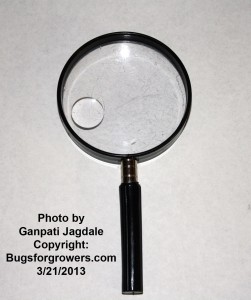
Since nematodes are like transparent white threads [Fig. 2], a black colored background [if you are not using microscope, a piece of black plastic trash bag (Fig. 3) or black kitchen counter top (Fig. 4) also works] is needed to observe the live or dead nematodes. Some time you may need a small dissecting or sewing needle to probe live but inactive nematodes [characteristics of some nematode species including Steinernema carpocapsae].
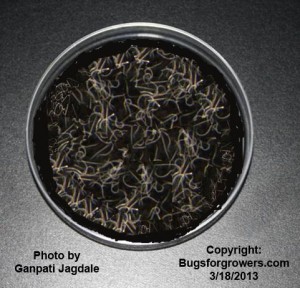

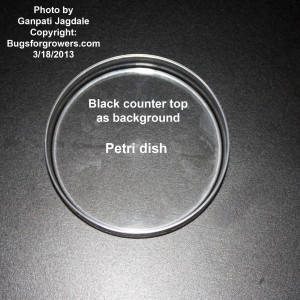
A glass or plastic petri dish [Fig.3 and 4] is perfect for examination of nematodes in water [Fig. 2] but if you do not have a petri dish then you can use a clear glass or plastic container [hereafter called “examination dish”]. If you are using a microscope, the height of examination dish should be low meaning it should be fitting between microscope stage and objectives but if you are using hand lens then the height of examination dish does not matter as long as you can hold lens at an appropriate distance between your eyes and nematode suspension.
In order to check nematode viability, nematodes must be first released from their formulation in water. Nematodes are very small [about 0.5 mm long] threadlike organisms [Fig. 2] and sold in different kinds of formulations including granular [Fig. 5] and sponge [Fig. 6] formulations. Since in each granule or in a small piece of sponge will contain several hundreds of individual nematodes, you need only a few granules or a small piece of sponge or a small portion of any other type of formulation to get a rough idea of nematode viability.
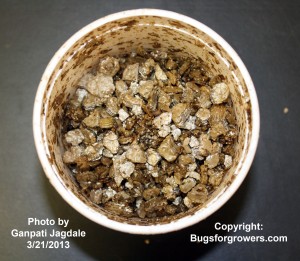
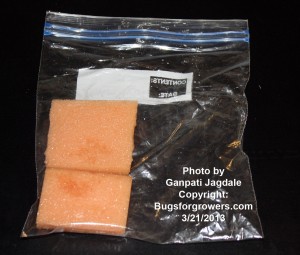
Following is a simple procedure for checking viability of nematodes after purchasing and before application in the targeted areas.
After opening a nematode package, remove 2-3 granules [Fig. 7]or cut 2-3 small pieces of sponge [Fig. 8] and transfer in a small cup or glass/plastic petri dish [Figs 7 and 8] containing water. Then allow nematodes to revive and escape from the formulation into the water.
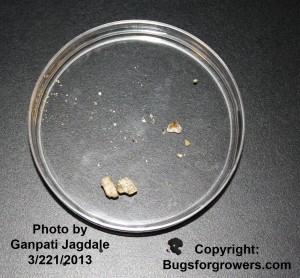
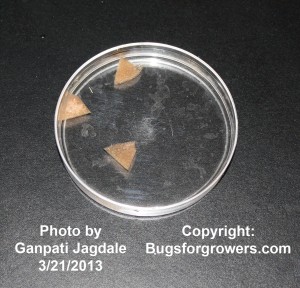
Also, if a large portion of formulation withdrawn for checking nematode viability, stir the nematode suspension with a small stick for even distribution of nematodes and then wait for a minute so that the heavy inert material of granular formulation will settle at bottom of cup or glass/plastic petri dish and nematodes will be floating in water. Then pour nematode suspension into an examination dish for examination of nematode viability. Put this examination dish on the black colored surface (see above) or on a microscope stage [it should have a light source at the bottom of stage], shine light from side and observe the nematodes. If you think, nematode suspension is still too cloudy and making it hard to see nematodes, then dilute it by adding more water.
Using either microscope or hand lens, you should be able to see white thread-like nematodes with a dark background in the suspension. If nematodes are alive, you will see sinusoidal [“S”-shaped] i.e. snake- like movement of all the species of beneficial entomopathogenic nematode including Heterorhabditis bacteriophora, H. indica and Sterinernema feltiae [Fig. 9] except Steinernema carpocapsae nematode that even it is alive, you will see it will be always in a resting/inactive state with a typical J-shape [Fig. 10]). To check the viability of S. carpocapsae, you need to probe their infective juveniles with a needle.


It is very easy to distinguish dead nematodes from live nematodes, as dead nematodes appear to be straight, their whole body is filled with water droplets [bubbles] and they do not move even after probing with a needle [Fig. 11].
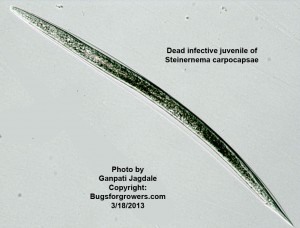
Note that you can also test the viability of nematodes following above stated procedure in a sub-sample [2-3 ml] withdrawn from a ready-to-use nematode sample prepared for direct applications in the field or gardens, yards and golf courses following instructions on the label.
